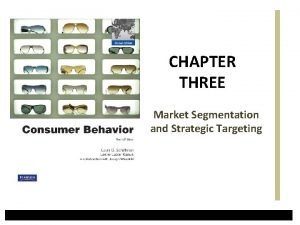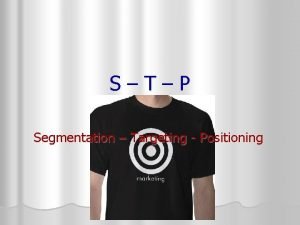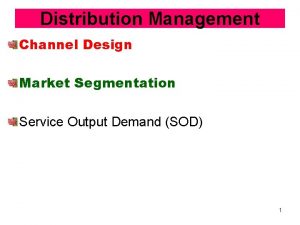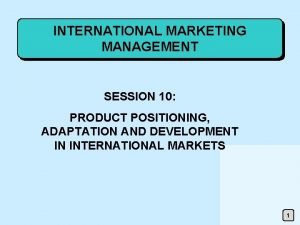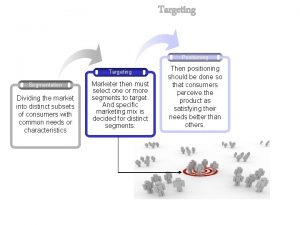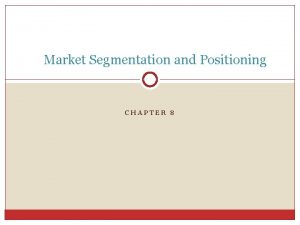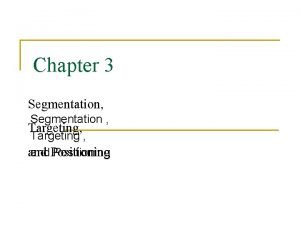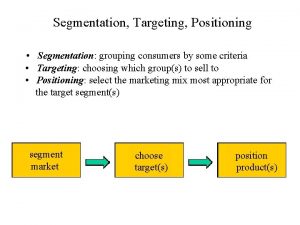Market Segmentation Targeting and Positioning chapter 8 Ch




































- Slides: 36

Market Segmentation, Targeting and Positioning chapter 8

Ch. 8 Objectives • Understand the concepts: market segmentation, and target marketing. positioning • Learn the advantages and disadvantages of target marketing • Discuss segmentation criteria, strategies, and seg. bases • Understand typical positioning strategies

What is a market? • Individuals or organizations who: – Are willing, able, and capable of purchasing a firm’s product – Segmentation is critical because demand is often heterogeneous

Market Segmentation/Targeting Market Segmentation is: • The process of dividing up the total market into distinct subsets of customers with common needs or characteristics Targeting is: • Selecting one or more segments that are appropriate

Target Marketing • Advantages – – – Easier analysis of potential and actual consumers Tailoring of products to market Assessment of demand potential Identify competing products Increased sales effectiveness

Target Marketing • Disadvantages – Increased marketing costs – More complex strategy to implement – Narrow segmentation can impact brand loyalty – Ethics and stereotyping issues – Can hinder a “Global” Brand Image – Faux segmentation may be viewed cynically • See Excedrin Migraine:


Market Criteria • Segmentable markets are: – Heterogeneous – Measurable – Substantial – Actionable • Companies must be able to respond to preferences with an appropriate marketing mix – Accessible • Market must be efficiently reachable

Segmentation Variables Demographic Segmentation Geographic Segmentation Situation Segmentation Psychographic Behavior/Usage Segmentation Benefits-Sought Segmentation

Demographics • • Age Income Gender Occupation Education Ethnicity Family Life Cycle

Segmentation Variables Demographic Segmentation Geographic Segmentation Situation Segmentation Psychographic Behavior/Usage Segmentation Benefits-Sought Segmentation

Geographics • • By region of country Micro-Beers do it Campbell’s Soup does it Frito-Lay does it:

Segmenting Consumer Markets Demographic Segmentation Geographic Segmentation Situation Segmentation Psychographic Behavior/Usage Segmentation Benefits-Sought Segmentation

Psychographic Segmentation – Grouping customers together based on social class, lifestyles and psychological characteristics (attitudes, interests and opinions)

Segmenting Consumer Markets Demographic Segmentation Geographic Segmentation Situation Segmentation Psychographic Behavior/Usage Segmentation Benefits-Sought Segmentation

Benefits Sought • Find (or create) a key benefit that the product satisfies • Toothpaste Example:

Segmenting Consumer Markets Demographic Segmentation Geographic Segmentation Situation Segmentation Psychographic Behavior/Usage Segmentation Benefits-Sought Segmentation

Situation Segmentation • Time of Year / Week, Event etc.

Segmenting Consumer Markets Demographic Segmentation Geographic Segmentation Situation Segmentation Psychographic Behavior/Usage Segmentation Benefits-Sought Segmentation

Behavior/Usage Segmentation • Markets can be segmented by how often or how heavily consumers use a specific product – 80/20 Principle - 80% of revenue generated by 20% of customers Light Users 80% Heavy Users 20%

Behavior/Usage Segmentation 80/20 true for many products • For Beer it’s 88% to 16% • Who are the heavy users?

Product Positioning

How to Position Brands: Positioning: • “an image that a product projects in relation to competitive products and to the firm’s other products”

7 Ways to Position (differentiate) a product • Show MGD clip(s) • How is MGD differentiated? 1) Product Attribute • It has something that others do not have • Whatever attributes seem important to consumers • Key attribute may in reality be bogus. . .

7 Ways to Position (differentiate) a product • Show Kia clip 2) By Competitor • Show Similarity • Show Difference

7 Ways to Position (differentiate) a product 3) By Cultural Symbol (brand marks)

TV Ad.

7 Ways to Position (differentiate) a product 4) By Price / Quality – Can be high or low (Generics) 5) By Product Class – Different type of product/service, but provides the same or better benefits • Example: New Am. Trak Acela service to NY

6) By Use or Application Typically used to add uses of product and expands user base

7 Ways to Position (differentiate) a product 7) By Product User • Product is positioned for a particular group of users • List some potential target markets for cellular phones:

Product Repositioning • What is meant by Repositioning? • Why might a company want to do it? (4 X) • Know any products that have been repositioned?

Mountain Dew (The most successful re-position in history) • What is MD’s current image/target market?

Mountain Dew (The most successful re-position in history) • Remember MD’s initial positioning? (1968 -Early 1970’s)

Mountain Dew (The most successful re-position in history)

Mountain Dew (The most successful re-position in history)

A rather unusual example of segmentation/positioning. . .
 Segmentation targeting positioning
Segmentation targeting positioning Sony market segmentation, targeting and positioning
Sony market segmentation, targeting and positioning Https://www.census.gov/popclock/
Https://www.census.gov/popclock/ Nokia target market
Nokia target market Market segmentation, targeting and positioning
Market segmentation, targeting and positioning Positioning methods
Positioning methods Market segmentation targeting and positioning of coca cola
Market segmentation targeting and positioning of coca cola Global market segmentation
Global market segmentation Nivea positioning
Nivea positioning Segmentation targeting differentiation and positioning
Segmentation targeting differentiation and positioning Nivea segmentation targeting and positioning
Nivea segmentation targeting and positioning Psychographic segmentation of nivea
Psychographic segmentation of nivea Pepsodent target market
Pepsodent target market Segmentation
Segmentation Undifferentiated products examples
Undifferentiated products examples Global segmentation strategy
Global segmentation strategy Global segmentation and positioning
Global segmentation and positioning Kfc segmentation targeting positioning
Kfc segmentation targeting positioning Principles of market segmentation
Principles of market segmentation Bases of market segmentation
Bases of market segmentation Targeting segment
Targeting segment Rural market segmentation and targeting
Rural market segmentation and targeting Consumer rooted segmentation
Consumer rooted segmentation Hcp segment
Hcp segment Resume jurnal
Resume jurnal Social marketing segmentation
Social marketing segmentation Resume jurnal
Resume jurnal Jurnal internasional segmenting, targeting, positioning
Jurnal internasional segmenting, targeting, positioning Designing a customer driven marketing strategy
Designing a customer driven marketing strategy Market leader challenger follower nicher examples
Market leader challenger follower nicher examples Market segmentation and selection
Market segmentation and selection Service and output
Service and output Positioning services in competitive markets
Positioning services in competitive markets Unfocused strategy example
Unfocused strategy example Positioning strategy
Positioning strategy International positioning strategies
International positioning strategies Ikea perceptual map
Ikea perceptual map






















